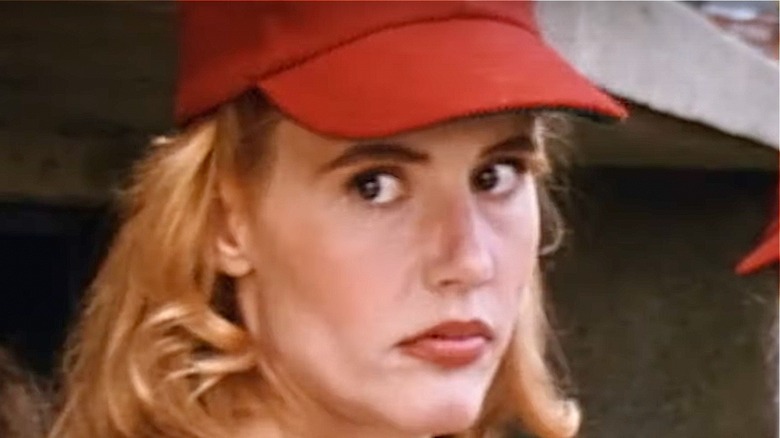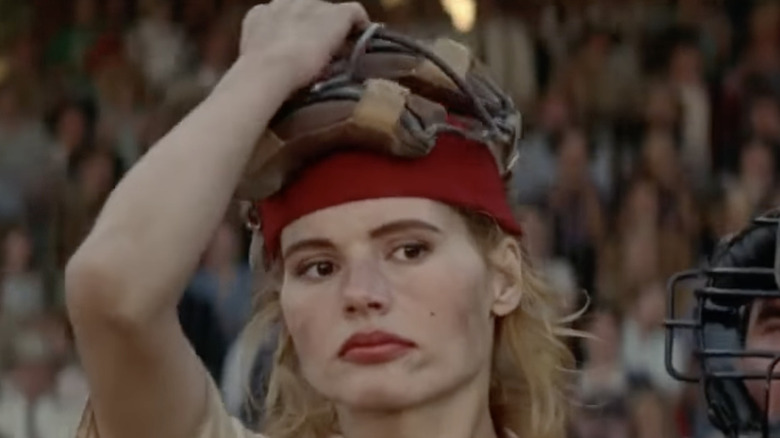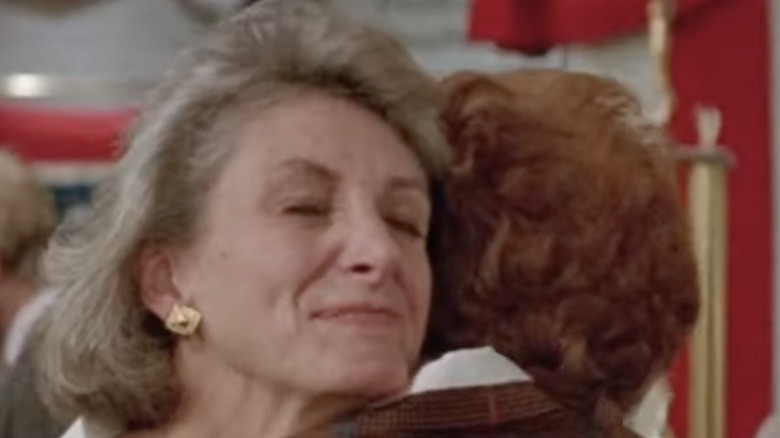The Ending Of A League Of Their Own Explained
"A League of Their Own" proved to be an instant baseball movie classic when it hit theaters in 1992. The fictionalized story of the World War II-era All-American Girls Professional Baseball League World Series captivated casual fans and baseball diehards alike with a glimpse into a fascinating period of the sport's history while many of the game's best male players were away at war.
Directed by Penny Marshall, the Tom Hanks and Madonna-led feature made $107 million at the U.S. box office, making it the seventh highest-grossing film of 1992 (via Box Office Mojo). The film has grown into a classic preserved in the U.S. National Film Registry at the Library of Congress (via the Los Angeles Times) and stands tall among other classic baseball movies like "The Natural" and "Field of Dreams."
The film follows sisters Dottie Hinson (Geena Davis) and Kit Keller (Lori Petty) in their adventures playing professional baseball during the 1943 season. While the sisters start the season on the same team, sibling rivalry takes over and results in Kit's midseason trade.
Dottie and Kit's sibling rivalry gives way to a World Series showdown
Of the two sisters, Kit is portrayed as someone who yearns to use pro baseball to get away from life in rural Oregon. Dottie, meanwhile, is content to stay home while her husband fights overseas in World War II, but she is a naturally more talented ballplayer than Kit. In fact, Jon Lovitz's scout character initially only wants to recruit Dottie for the women's pro league. Kit is included only because she managed to change Dottie's mind about participating in the first place (via YouTube).
Dottie becomes the face of the league with her acrobatic catches behind home plate and high-quality play, while Kit struggles to achieve the prominence she hoped for in her older sister's shadow. Dottie recognizes how this affects her sister and requests a trade for herself so Kit can shine as the Rockford Peaches' star — but Kit is actually traded to the Racine Belles as a result. The siblings argue when the trade happens, leaving Kit and Dottie on bad terms as the season ends and the World Series approaches.
Rockford and Racine meet in the World Series, and Kit finally bests her older sister. She scores the championship-winning run by knocking over Dottie at home plate, dislodging the ball from her hands. While Kit finally gets her moment as a star, whether or not Dottie drops the ball on purpose to let Kit win has been hotly debated over the years.
Dottie drops the ball — but was it on purpose?
Did Dottie deliberately drop the ball or not? There is solid reasoning behind both lines of thinking, but it's unknown exactly what the filmmakers intended. For her part, Lori Petty has said on Twitter that Dottie did not intentionally drop the ball. According to USA Today, actress Bitty Schram, who played right fielder Evelyn Gardner, previously speculated Dottie likely did drop it on purpose.
"If I had to pick, I would say subconsciously yes," Schram said. "Because [Dottie] knew how much more [winning] meant to Kit, and she was too good of a player [to drop the ball otherwise]. From what I remember subconsciously, yes."
The film's opening scene, which features an older Dottie's two grandsons, gives further insight into the sibling's dynamic. It appears that Dottie recognizes the same competitive energy between her and her sister in her grandsons, and she offers some advice. "Now remember, no matter what your little brother does, he's littler than you are, so give him a chance to shoot," Dottie tells the older boy, Jeffrey (via YouTube). Her only advice to his younger brother, Bobby? "Kill him."
Based on the scene with Dottie's grandsons, it seems Dottie learned that she needed to occasionally let up on Kit and give her an opportunity to best her — and Kit needed to realize she shouldn't let up when the time came. Does that include Dottie purposefully dropping a ball to lose the World Series? Perhaps it's best left open to interpretation.
Dottie and Kit ultimately reconcile, and the Rockford Peaches reunite in present-day
With Kit a champion and Dottie's obligation to professional baseball over, the sisters reconcile. Dottie announces her intention to return to Oregon with her husband, who has returned from the war, and they have children. Kit decides to stay in Chicago, find a job, and continue playing baseball when the next season starts.
In the present day, Dottie attends the opening of the AAGPBL exhibit at the National Baseball Hall of Fame in Cooperstown, New York, reuniting with the women she played ball with in 1943 and ultimately seeing Kit again. The film's final sequence shows the women exploring the Hall of Fame and museum, highlighting the league's valuable place in baseball history alongside legendary figures like Babe Ruth. Although Dottie is shown throughout the film to think little of her baseball-playing days, the movie's final scenes emphasize how important the league's real-life existence was — both to a country that missed many of its male athletes during WWII and to the larger fight for gender equality.



